In the third week of the course, on Monday, my group was given the task of Making A. At first, I saw the task and found it very confusing and complicated. At first, I found the task very confusing and complicated and I didn’t really understand what A, B and C were and what kind of items could be linked according to such instructions. Then the members of our group launched into imagination together. What we were thinking about was exploring the relationships in the universe, thinking about the sun, the stars, the moon, the earth and the whole universe, where the sun rises and the stars and the moon disappear, but these together add up to day and night. We tried to think about the connections and tried to explain these relationships in terms of instructions, and although our theories were a bit far-fetched during the discussion, we did think about it and try this whole process. We then read the RSVP documentation to understand the relationship between Resource, Score, Valuaction and Performance according to the diagram. We then found that Valuaction is more of a result of Score and can also be a form of process, and that the RSVP cycle can be applied to a variety of activities where RSVP does not need to be present in all of them, but only in some of them to create a relationship. I then watched a video on critical thinking and they mentioned workshops, presentations and some critical reading. What I found more inspiring was that the video said that when talking to tutors about arguments, I needed to let them know what I was saying to myself and then go on to help me develop and recommend other reading material, and that the more I did that, the better I would do it and the further I would go and become more specialised. I think I will also need to show my tutors my views when I write in the future and then keep integrating them in depth, which is a gradual and progressive process.
Before the class on Wednesday, I read our group’s required reading material, The Ambiguity of Play, which began with Play and Ambiguity. But after reading this chapter, I still feel that the concept of play is a very conscious and abstract concept. But in the next chapter The Diversity of Play Forms and Experiences the author goes on to suggest many concrete things on, such as the act of playing, social play, various kinds of performance and so on. And all these manifestations vary depending on the identity of the player, thus making Play itself more versatile. I then read the Rhetorical related section, which I really didn’t quite understand the concept the author was trying to convey. Later on in class we asked Jake about this and I think that Rhetoric and Play are not necessarily linked to each other, it might just be a way that some people or some thinkers like to express it.
In the next week, I discussed our group’s Score and Action Plan with our group, which focused on relationships. We thought about the Score from last Monday’s paper – Making A. We then chose the theme of relationships from time, relationships, gaps, isolation, space and identity, using playing cards as the vehicle for our group Play. During the discussion, we discovered that people always want to explore and anticipate the future and the relationship with this person. This was very similar to the Western occult and tarot cards I had learned about in the previous two weeks, so I came up with the idea of using a new poker rule to replace the tarot cards.
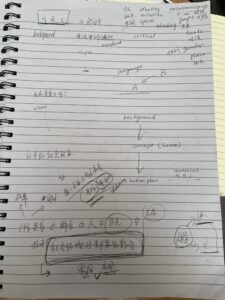
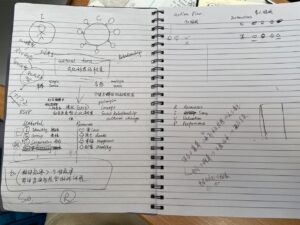
Then as we continued to delve into the theme of relationships, we mainly wanted to find the relationship between a single subject and a group in society, use our rules to play cards and then compare and contrast, and finally conclude that the effect of the experience of two people doing something together in a relationship is greater than the effect of two single subjects acting alone. What we wanted to achieve was a 1+1>2 effect. Although our video is not that sophisticated, what we want to verify is that the role of the team is important. We wanted to do an experiment-like effect by controlling for the number of people as a variable, where our Score is fixed, and then doing a comparison between multiple people and a single person. We would then find that the sensory experience of an activity performed by multiple people was superior to that of a single person, so we were thinking about a multi-sensory crossover experience in an interactive experience installation, where people and machines interacted so that they would immerse themselves in experiencing the artistic effects.
During this time I modified the specific rules of our Score, I modified two main areas. The first was the meaning of the suits in the cards. There are four suits in the playing cards, initially the ♠ of Spades, ♣ of Clubs, ♥ of Hearts and ♦ of Diamonds, representing Hate, Help, Love and Money respectively, but after thinking about it I decided that it was unbalanced that three of them were positive and only one was negative. The second aspect of the change is that the player can draw a second card to determine the reason for the relationship of the first card. This is because during the actual experience there is a desire to find out why, so I added this further rule to make the whole Play process more fair and interesting.
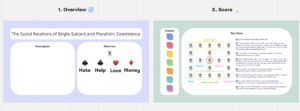
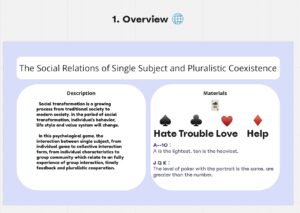
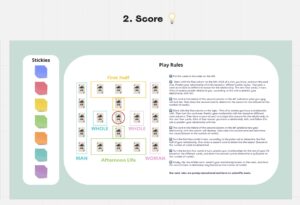
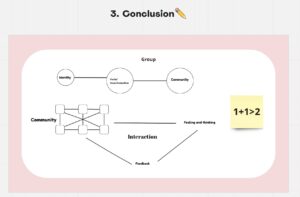

When I presented the work done by our group to the class on Thursday, I was very proud of myself because I thought from the bottom of my heart that our group had interesting content.
These are my reflections on week 3 and week 4.


www.fooddoz.com
22nd October 2022 — 10:43 am
Thanks for sharing the post.
s2248556
23rd October 2022 — 3:11 pm
From the reflection written by the blogger, I can see that she worked hard and very seriously to complete this group assignment. The game settings they designed are also very comprehensive, and it was fun to try and play.
s2413068
23rd October 2022 — 6:50 pm
Very interesting blog! This article posts your game designed this week and includes some reflection on the work you undertook in your group, there was a clear chart of a new score. You note that you evaluated and modified the specific rules of your Score. I remember that your group work posts were really interesting and is about an interactive fruit game on a website. I agree that your group had interesting content.
s2449532
23rd October 2022 — 11:58 pm
The authors constantly break the rules to rebuild the rules, using new poker rules instead of tarot cards, gradually set up a set of their own 1+1>2 effect, want to find the relationship between individual subjects and groups in society, interactive experience installation for multi-sensory cross experience, human-machine interaction, very much looking forward to the show.
Kneel, Mulholland: Drive!
26th October 2022 — 12:41 pm
https://blogs.ed.ac.uk/s2321841_themes-in-contemporary-art-2022-2023sem1/2022/10/14/42/
A few comments on what you have posted for Theme 2:
Borui, you launch straight into a description of the first session and work your way through each step of the process during the theme. This is insightful and analytical at times, albeit it does perhaps offer a bit too much empirical detail at the expense of more distanced critical reflection on the theme itself (play) and theories of play.
You pick apart the creation of the playing cards game, describing its genesis. While creating the game could have benefited from some more insight into game-design, it’s actually a viable working prototype. This is a really good place to arrive at in under two weeks! It made sense to quickly repurpose standard 52 deck playing cards for this. If you want to take the use of cards further, you could easily create your own custom cards. Here’s a simply generator for Cards Against Humanity for example: http://mywastedlife.com/CAH/ I liked reading about how you all arrived at the theme of “relationships from time, relationships, gaps, isolation, space and identity” – I think there’s more that you could do with this as a group. Why not continue to meet to rework and polish the game?
I feel that reflecting more on two components would make an interesting discussion.
Firstly, I’d suggest doing more cultural theory work on ‘Divination’. It’s fruitful to compare Chinese divination (bǔshì) – such as the I Ching – with ‘Western’ esoteric divination such as the (mid-15th century Italian) Tarot. You can find lots on this if you look back at the reading list for Weird Studies (Comparative Esoterica). (NB: divination (bǔshì) and fortune telling are very distinct in the Chinese tradition, is this so in Europe?) European Tarot cards are the root of many playing cards that we use today for all sorts of ‘games’ – so there’s an interesting ‘technology’ or ‘media’ to examine here.
Secondly Borui, I really want to see you consult the play theory literature in more depth. I’d like to know, for example, how the principles outlined in Lawrence & Anna Halprin’s ‘Summary of the Characteristics of Scores‘ (1969) relate (or not) to what you created as a group. Did you learn anything from ‘What Play is’ (pp1-18) in Play Matters (Sicart, 2014)?